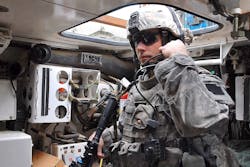CACI, Perspecta Labs to help DARPA develop enabling technologies for next generation secure tactical radios
ARLINGTON, Va. – U.S. military researchers are asking two U.S. companies to develop secure radio frequency (RF) transmitter and receiver technologies to enable the next generation of secure military tactical radio systems.
Officials of the U.S. Defense Advanced Research Projects Agency (DARPA) in Arlington, Va., awarded contracts last week to CACI International Inc. in Florham Park, N.J.; and to Perspecta Labs Inc. in Basking Ridge, N.J., for the Wideband Secure and Protected Emitter and Receiver (WiSPER) project.
CACI won a $30.7 million contract on 25 March, and Perspecta Labs won a $19.2 million on 24 March. The companies are participating in the project's first phase, by carrying the WiSPER system architecture through a conceptual design supported by modeling and simulation, culminating in a benchtop implementation and lab test. More WiSPER phase-one contracts may be awarded.
Today's military secure tactical radios achieve security by spreading transmitted content over time and operating frequency in attempts to reduce transmitted power density and operate below the adversary's receiver detection limit.
Related: Harris wins contract to provide Special Operations forces with new manpack radio
Still, spread-spectrum techniques lack sufficient complexity to evade detection by modern signals intelligence (SIGINT) receivers or interception by compromised devices.
Today's secure military tactical radio systems are vulnerable to hypersensitive and collaborative receivers.
Hypersensitive receivers use cryogenic-cooled energy detectors and cyclostationary processing over prolonged observation time to increase detection sensitivity by reducing uncorrelated noise. This technique reveals chip rate and modulation format to establish spread-spectrum transmissions. Collaborative receivers, meanwhile, involve multi-receiver networks that coherently recombine power to detect the transmitter.
Today's spread-spectrum approaches have several limitations. Narrowband signals are only spread in the time and frequency domains and contain cyclic features, for example. Narrowband RF waveform typically use fixed and limited dynamic range of less than 30 decibels, leading to the inability to remain undetectable while providing persistent communications.
Related: Air Force eyes next-generation tactical data links gateway for jet fighter communications
New chaotic waveforms that reduce cyclic features only provide marginal reduction of detectability, require higher signal-to-noise ratios to synchronize and operate, and are not sufficiently featureless to evade detection. Directional beams and reconstruction of coherent scattered signals, in addition, are impractical for today's tactical radios.
While spread-spectrum techniques minimize the signal strength to avoid detection, today's tactical radios face additional operational challenges from channel impairments that reduce the link margin of the radio.
With fixed operational frequency and bandwidth, existing tactical radios provide limited options and margins to sustain persistent transceiver operations under varying and unpredictable natural and man-made channel impairments.
Instead, the WiSPER program seeks to develop fundamentally disruptive wireless air interface transceiver technology to enable and sustain secure high-bandwidth RF communication links. The WiSPER wideband adaptive air interface also will mitigate impairment from dynamic harsh and contested environments to maintain a stable communication link.
DARPA researchers anticipate that WiSPER capabilities also will provide future U.S. warfighters with a dominant technology advantage over their adversaries. Researchers want radios small enough for portable or ground installations.
WiSPER will be a four-year, three-phase program with an 18-month first phase, an 18-month second phase, and yearlong third phase. Several phase-one contracts are expected, with a reduced number of participants in the second and third phases.
Related: What 5G means to the military
Phase 1 performers will carry the WiSPER system architecture through a conceptual design supported by modeling and simulation, culminating in a benchtop implementation and lab test.
Phase 2 performers will improve the design, culminating in a transportable implementation and field test. Phase 3 performers will further optimize the air interface to demonstrate adaptation to weather and other impairments in a portable prototype implementation.
For more information contact CACI International online at www.caci.com, Perspecta Labs at www.perspectalabs.com, or DARPA at www.darpa.mil.
About the Author
John Keller
Editor-in-Chief
John Keller is the Editor-in-Chief, Military & Aerospace Electronics Magazine--provides extensive coverage and analysis of enabling electronics and optoelectronic technologies in military, space and commercial aviation applications. John has been a member of the Military & Aerospace Electronics staff since 1989 and chief editor since 1995.
